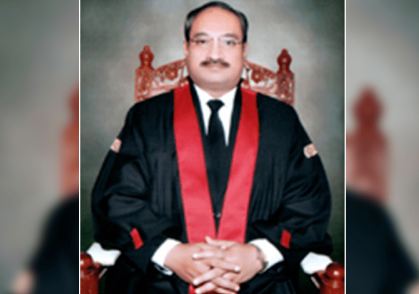Lahore High Court’s (LHC) Justice Ali Baqar Najafi on Friday become the latest jurist to receive a “suspicious” letter, according to an official.
On Tuesday, it emerged letters were delivered to all eight Islamabad High Court (IHC) judges the day before in white envelopes sealed with cello-tape. The names of the judges and the address of the IHC were written on the envelopes. Sources said the letters had carried a threatening sign and accused the judges of being responsible for problems faced by the people of Pakistan.
The staff of two judges had opened the envelopes and found a suspicious powder inside. The matter was reported to the IHC registrar who summoned the police staff deputed for the security of the high court, after which a case was registered under section 507 (criminal intimidation by an anonymous communication) of the Pakistan Penal Code (PPC) and section 7 (punishment for acts of terrorism) of the Anti-Terrorism Act (ATA).
The letters were issued with the incomplete address of the sender, the FIR said. The letters while giving reference to Tehreek-i-Namoos Pakistan criticised the justice system, it said, adding that a particular photo and English word “Bacillus Anthracis” were included in the letters for the threat.
The next day, similar letters arrived in the Supreme Court and the LHC prompting the Counter-Terrorism Department (CTD) to register two cases in Islamabad and Lahore.
The letters in the top court were sent to Chief Justice of Pakistan (CJP) Qazi Faez Isa, Justice Athar Minallah, Justice Jamal Khan Mandokhail, and Justice Aminuddin. They were received at the Receipt and Issue (R&I) Branch of the apex court from where they were forwarded to the staff of the judges.
The letters sent by an unknown group threatened the judges of the Supreme Court for “rescuing evil”. Suspicious powder was found inside the envelopes and sent to the forensic lab.
An amount of the suspicious powder was taken from each envelope and was to be sent to the Forensic Science Laboratory Islamabad on Thursday for toxicological and chemical tests.
At the LHC, the judges who received the letters were Chief Justice Malik Shahzad Ahmad Khan, senior puisne judge Justice Shujaat Ali Khan, Justice Shahid Bilal Hassan, Justice Aalia Neelum, and Justice Abid Aziz Sheikh.
The personal staff of the judges found the letters in the daily mail received at the high court, an official told Dawn on condition of anonymity. He said the staff of all judges at the LHC was already alert in the wake of letters sent to the IHC judges.
Subsequently, Prime Minister Shehbaz Sharif said on Thursday that the government would launch a probe into the matter “with a sense of responsibility”.
The developments come more than a week after six IHC judges wrote a startling letter to the Supreme Judicial Council (SJC) members, regarding alleged interference by the country’s security apparatus in judicial matters.
Today, Justice Najafi became the sixth LHC judge to receive a “suspicious” letter. According to Inspector Muhamad Anis of the Special Branch, the letter was received by Justice Najafi’s secretary.
He added that of the five letters received by the secretary, “one was suspicious”. The letter concerned was then handed over to the CTD, Anis confirmed.
However, he did not comment on whether the letter contained any toxic substance or threatening content.
Investigators hunt source of ‘toxic letters’
As PM Shehbaz vowed to solve the mystery of “toxic letters” on Thursday, the CTD appeared to be in a bind in its efforts to trace those behind these letters.
Investigators in Islamabad have traced the letters sent to judges of the superior courts to the General Post Office in Rawalpindi, but due to the absence of CCTV cameras on the premises, the senders have yet to be identified.
After the letters were opened by the court staff, it was widely believed that the suspicious powder in the envelopes was ‘anthrax’, a harmful substance that causes an infection upon contact with skin.
However, forensic analysis has revealed that the letters sent to LHC judges did not contain anthrax, but rather “carbohydrates having arsenic traces”. Initial investigations have revealed that the arsenic was not in its pure form.
“There were no traces of anthrax or any other toxic chemicals,” sources told Dawn. They added the investigating agencies had also been instructed to trace the fingerprints on the envelopes to catch the attackers.
The Punjab Safe City Authority had also been instructed to trace the senders of the suspicious letters through its surveillance cameras installed across the provincial capital.
Task force formed
In response to the letters received by the LHC judges, the home department held a meeting in Lahore — attended by top police and forensic officials — to review the toxic substances found in the envelopes.
The meeting did not rule out the role of foreign agencies and decided to expand the canvas of the investigation. According to sources, the CTD constituted a task force headed by the DIG to trace the culprits and their motives behind sending these documents.
With regard to the protection of judges and their staff members, the home department and other line agencies have decided that the judges be provided scanning machines to scan before opening suspicious letters or envelopes. It was also decided that all LHC judges’ staff members be offered training besides equipping them with gadgets to handle suspicious letters and articles in an informed manner.
SC, IHC letters traced to GPO Rawalpindi
As the investigation in Islamabad inched forward, the CTD team led by DIG Shahzad Nadeem Bukhari traced the letters sent to the SC and the IHC to the General Post Office in Rawalpindi.
Sources privy to the investigation told Dawn that following the delivery of these “toxic” letters to the judges of the apex court and the high courts, the investigation team had managed to establish that they were dispatched from the Rawalpindi GPO and the sender mailed all these letters through a post box.
Though the letterbox has been identified, the identity of the sender was still not known.
Sources said that the efforts were being made to trace the sender through CCTV footage and the authorities concerned had been asked to furnish the footage.
Sources said that it was difficult to ascertain who brought these letters to the post office since there were no cameras installed inside the crowded premises. According to sources, the investigation team has asked adjacent offices and buildings to share footage from their respective CCTV cameras.
When contacted, Islamabad Police Spokesperson Taqi Jawad told Dawn that the CTD was investigating the case. According to him, DIG Operations Syed Shehzad Nadeem Bukhari was personally supervising the investigation. He expressed hope that the investigation team would trace the senders soon.
Following the incident, the IHC administration took several precautionary measures and the administration has decided to return all letters without a proper sender’s address.
The text in the letters to the top court threatened that the toxic substance in the envelopes was a warning for others to ‘repent’ or face the consequences. The phrase “Welocme [sic] to Bacilus anthracis [sic] !!!” was also written along with a photo of a human skull and bones.
















